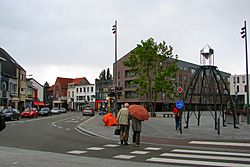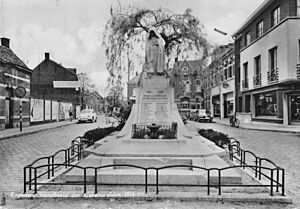Kapellen, Belgium facts for kids
Quick facts for kids
Kapellen
|
|||
|---|---|---|---|

Town centre
|
|||
|
|||
| Country | Belgium | ||
| Community | Flemish Community | ||
| Region | Flemish Region | ||
| Province | Antwerp | ||
| Arrondissement | Antwerp | ||
| Area | |||
| • Total | 37.11 km2 (14.33 sq mi) | ||
| Population
(2018-01-01)Lua error in Module:Wd at line 1575: attempt to index field 'wikibase' (a nil value).
|
|||
| • Total | Lua error in Module:Wd at line 1,575: attempt to index field 'wikibase' (a nil value). | ||
| Postal codes |
2950
|
||
| Area codes | 03 | ||
| Website | www.kapellen.be | ||
Kapellen is a town in the Antwerp province of Belgium. It is located in the northern part of the province, in an area called the Campine.
Kapellen is made up of the main town and several neighborhoods like Kapellen Center, Kapellenbos, Hoogboom, and Zilverenhoek. Many parts of Kapellen are known for their beautiful houses, large country homes, and even castles. People who want to escape the busy city often come here to enjoy the peaceful nature.
In 2021, Kapellen had about 27,157 people living there. The total area of the town is about 37.11 square kilometers. The town also has a famous football (soccer) club called R. Cappellen F.C., which has played in national leagues for many years.
Contents
History of Kapellen
The areas that now form Kapellen have a long history, dating back to the 13th century. For example, the neighborhood of Hoogboom was first mentioned in documents from 1267. The main center of Kapellen, called Hoghescote back then, appeared about 10 years later. Zilverenhoek, another neighborhood, became part of Kapellen much later, in 1983.
How Kapellen Became a Town
For a long time, Kapellen was part of a larger area called the lordship of Ekeren. A lordship was like a territory ruled by a powerful family or lord. Over the centuries, different parts of this land changed owners many times. By 1714, one family, the Salm-Salms, owned the entire lordship of Ekeren.
During the time when France occupied Belgium, in 1795, Kapellen became part of the nearby town of Stabroek. But just five years later, in 1800, Kapellen became its own independent municipality (town). Since then, it has slowly grown by adding parts of other nearby towns like Ekeren, Hoevenen, and Stabroek. The current borders of Kapellen were set in 1983 when Hoogboom and Zilverenhoek officially joined.
The Old Church of Kapellen
The oldest building in Kapellen is its church. For many years, a small chapel was enough for the local people. But over time, the church was built up and improved. For example, the front part of the church, called the chancel, dates back to the 14th century. The Transept, which is the part that crosses the main body of the church, was built in the 16th century. Later, in the 1800s, the church's tower and inside were updated to look like Neo-Gothic style.
Times of Trouble and Growth
Kapellen has seen periods of both growth and hardship. During the Fall of Antwerp (a major historical event), Kapellen suffered a lot. Most of its important buildings and 90% of its homes were destroyed. After a short period of recovery, the plague hit in 1623, causing more suffering. The town truly started to recover in 1674 when the church was rebuilt.
However, this recovery was stopped by World War I. Many people died due to forced service in the German army and the Spanish flu epidemic. After the war, there was a brief recovery until a crisis hit in 1930. The real comeback for Kapellen happened after World War II. The town was set free on October 4, 1944, by Canadian soldiers.
Population Changes
The number of people living in Kapellen has changed a lot over the years. <graph>{ "version": 2, "width": 600, "height": 200, "data": [ { "name": "table", "values": [ { "x": 1806, "y": 913 }, { "x": 1816, "y": 903 }, { "x": 1830, "y": 1445 }, { "x": 1846, "y": 2504 }, { "x": 1856, "y": 2453 }, { "x": 1866, "y": 2760 }, { "x": 1876, "y": 3031 }, { "x": 1880, "y": 3061 }, { "x": 1890, "y": 3489 }, { "x": 1900, "y": 4072 }, { "x": 1910, "y": 5282 }, { "x": 1920, "y": 6291 }, { "x": 1930, "y": 7926 }, { "x": 1947, "y": 9680 }, { "x": 1961, "y": 11474 }, { "x": 1970, "y": 13352 }, { "x": 1980, "y": 14304 }, { "x": 1982, "y": 14648 }, { "x": 1983, "y": 22471 }, { "x": 1985, "y": 22549 }, { "x": 1990, "y": 23977 }, { "x": 1995, "y": 25290 }, { "x": 2000, "y": 25671 }, { "x": 2005, "y": 25975 }, { "x": 2006, "y": 25948 }, { "x": 2007, "y": 26104 }, { "x": 2009, "y": 26410 }, { "x": 2010, "y": 26423 }, { "x": 2011, "y": 26434 }, { "x": 2012, "y": 26532 }, { "x": 2013, "y": 26483 }, { "x": 2014, "y": 26529 }, { "x": 2015, "y": 26642 }, { "x": 2016, "y": 26745 }, { "x": 2017, "y": 26750 }, { "x": 2018, "y": 26771 }, { "x": 2019, "y": 26850 } ] } ], "scales": [ { "name": "x", "type": "linear", "range": "width", "zero": false, "domain": { "data": "table", "field": "x" } }, { "name": "y", "type": "linear", "range": "height", "nice": true, "domain": { "data": "table", "field": "y" } } ], "axes": [ { "type": "x", "scale": "x" }, { "type": "y", "scale": "y" } ], "marks": [ { "type": "line", "from": { "data": "table" }, "properties": { "enter": { "x": { "scale": "x", "field": "x" }, "y": { "scale": "y", "field": "y" }, "y2": { "scale": "y", "value": 0 }, "interpolate": { "value": "monotone" }, "stroke": { "value": "steelblue" }, "strokeWidth": { "value": 3 } } } } ] }</graph> As you can see from the graph, Kapellen's population has grown significantly over time. In the early 1800s, there were only about 900 people. By the early 1900s, it had grown to over 4,000. After a big change in town borders in 1983, the population jumped to over 22,000. Today, it's around 27,000 people.
Transport in Kapellen
Kapellen has seen many changes in how people travel to and from the town.
Roads and Railways
In 1759, a special road made of cobblestones was built connecting Kapellen to Merksem. Today, this road is known by different names depending on where you are, like Kapelsesteenweg or Antwerpsesteenweg.
A very important change happened in 1853 when the railroad line between Antwerp and Rotterdam was built. The first steam train ran through Kapellen railway station in 1854. This new train connection was a big deal! It made it easy for wealthy people from Antwerp to build beautiful villas and country homes in Kapellen, turning it into a popular place to live.
The Era of Trams
Local tram lines also reached Kapellen. On July 31, 1927, the first local railway opened. The tram line was extended to the border of Putte on December 1, 1928. For a short time, the tram and the main railroad even crossed paths.
More tram connections were added in the 1930s, making it easier to travel between Kapellen and nearby towns like Hoevenen and Antwerp. However, the tram era eventually ended. The very last tram rode through Kapellen on May 26, 1967.
Famous People from Kapellen
Many talented people have lived in Kapellen:
- Christine Soetewey – A retired Belgian high jumper.
- Sam Bettens and Gert Bettens – Musicians, known for the band K's Choice.
- Geert Grub (1896–1980) – A poet, writer, and Flemish activist.
- Margaretha Guidone – An activist who works for the environment and against global warming.
- Didier Ilunga Mbenga – A professional basketball player who played in the NBA.
- Baron Paul Kronacker (1897–1994) – A well-known politician.
- Tom De Mul – A former professional football player.
- Kevin Van Dessel – A former professional football player.
- Dirk Van Mechelen – A politician and Flemish minister.
- Thomas Vermaelen – A former professional football player.
- Gordan Vidovic – A former professional football player.
- Rocco Granata – A famous singer.
- Mathieu van der Poel – A well-known cyclist.
See also
 In Spanish: Kapellen (Bélgica) para niños
In Spanish: Kapellen (Bélgica) para niños




